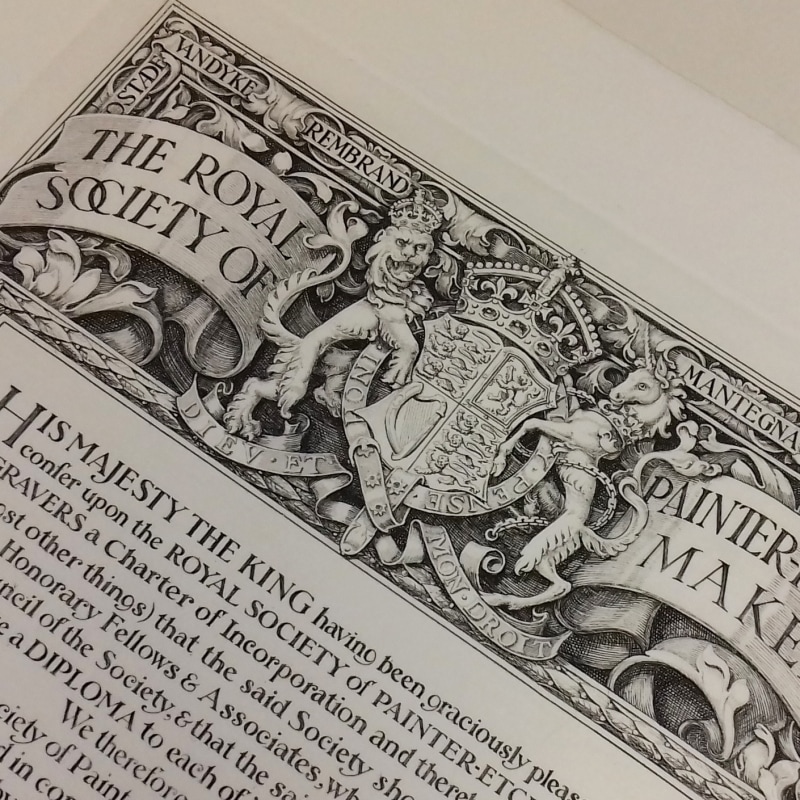Why is the Royal Society of Painter-Printmakers abbreviated to 'RE'?
We are often asked why members of the Society are given honorifics 'RE' after their name. These honorifics show whether they are an Associate Member (ARE) or a full fellow (RE) or hold a position such as President (PRE).
But where does the ‘E’ in ‘RE’ come from?” This is explained through the evolution of the Society and it’s various names…
Sir Francis Seymour Haden founded the ‘Society of Painter-Etchers’ in 1880 from his living room at 38 Hertford Street in London’s Mayfair. He did this in company with five other London artists, namely: James Tissot, Alphonse Legros, Hubert von Herkomer RA, Heywood Hardy and Robert Walter Macbeth RA.
The founding members of the Society were artists who made etchings and engravings as a creative art form and they set up the RE in response to the Royal Academy's reluctance to recognise original printmaking as an independent art form as they did painting or sculpture.
Printmaking at this time is more often a technique used by copyists to reproduce paintings, rather than make artworks in their own right. The term 'painter' in 'Painter-Etchers' was included to make this distinction between original creative printmaking versus copyist reproduction prints.
The Society is given the name the Society of Painter-Etchers, which is where the 'E' in RE originates.
The Society received their Royal Charter from Queen Victoria in 1888 and became the Royal Society of Painter-Etchers. Although they changed their name in 1991 to embrace a broader range of printmaking practices, they have retained the abbreviation RE to this day as both their identity and the qualifying letters that follow an elected member's name.
RE Timeline
1880 - Sir Francis Seymour Haden, with 5 other members, founds the Society of Painter-Etchers and becomes its first President.
1888 - Queen Victoria allows the Society to assume the title of Royal, so it becomes the Royal Society of Painter-Etchers.
1898 - Queen Victoria allows the RE’s title to be enlarged to become the ‘Royal Society of Painter-Etchers and Engravers’, this is to allow (controversially) the inclusion in exhibitions of copper plate copyists’ engravings and mezzotints from which some members make a living, alongside their original prints.
1911 - King George V grants a Charter of Incorporation and Bye-Laws to the RE, by which time the Society has grown in prestige and become fully established. Full fellows are entitled to use the post-nominals ‘RE’.
1920 - RE Membership expands to embrace artists producing relief engravings.
1991 - The Society’s name becomes the ‘Royal Society of Painter-Printmakers’ but retains its ‘RE’ epithet. The bye-laws are changed to make artists using all forms of original printmaking eligible for membership.
The above is taken from the Timeline: Sir Francis Seymour Haden and the history of the RE by Anne Desmet RA RE and Joseph Winkelman PPRE Hon RWS in the 2018 publication ‘Print REbels, Haden, Palmer, Whistler and the Origns of the RE' by Edward Twohig RE.
RE HISTORY AND THEIR AFFILIATION WITH THE RWS & BANKSIDE GALLERY
Both the Royal Watercolour Society and the Royal Society of Painter-Printmakers were born from a feeling that the Royal Academy undervalued their respective media, and failed to show them to advantage, if at all. The two societies joined forces in exhibition rooms at 5a Pall Mall in 1889 and never looked back. In 1938 they moved to 26 Conduit Street, London W1, when the lease at 5a Pall Mall East expired and the block was redeveloped.
As the 20th century went on, property prices in the West End rose. In 1973 the Conduit Street lease was renewed for seven years but the rent was increased to £700, an unsustainable price for the two societies. A committee of Harry Eccleston, Andrew Freeth, Malcolm Fry (RWS and RE Secretary), Richard Seddon, and Rodney Millard was set up to consider the question of new premises. But as chance would have it, a fortuitous dinner invitation led to the foundation of Bankside Gallery, and the rescue of both societies.
A fundraising campaign followed along with the inevitable delays and complications involved in a major building project, but finally, in 1980, the societies were settled in their new home and this partnership continuse to this day, with 2 regular joint exhibitions of the Societies at Bankside Gallery every year.
Several RE members are also members of the RWS and Past RE Presidents are given Honorary Membership of the RWS, an arrangement reciprocated to the RWS Presidents also.
